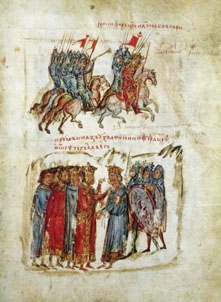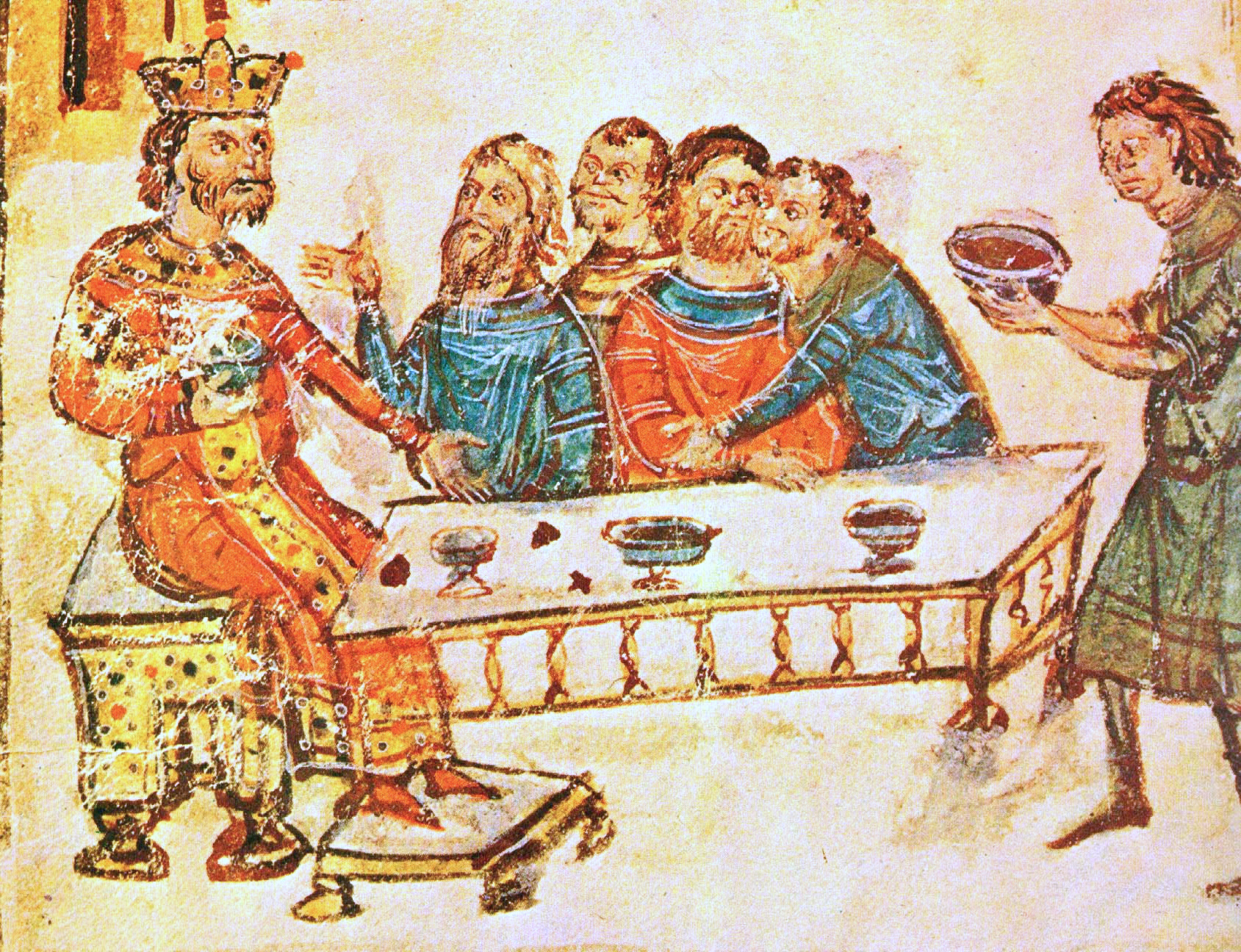|
812
__NOTOC__ Year 812 ( DCCCXII) was a leap year starting on Thursday (link will display the full calendar) of the Julian calendar. Events By place Byzantine Empire * January 11 – Ex-emperor Staurakios, a son of Nikephoros I, dies of putrefaction in his wounds (see 811) in a monastery. He has reigned only two months and eight days, before being exiled by senior officials in Constantinople. * Emperor Michael I re-opens peace negotiations with the Franks, and recognizes Charlemagne as emperor (''basileus'') of the Frankish Empire. In exchange for this recognition, Venice is returned to the Byzantine Empire. * Byzantine–Bulgarian War: The Bulgars, led by Krum, ruler ('' khan'') of the Bulgarian Empire, launch an invasion against the Byzantines. They capture the fortress cities of Develt and Mesembria, near the Black Sea. Europe * Charlemagne conquers Catalonia, as far south as the River Ebro and the Balearic Islands. The counties come under the rule of Bera, count ... [...More Info...] [...Related Items...] OR: [Wikipedia] [Google] [Baidu] |
Charlemagne
Charlemagne ( , ) or Charles the Great ( la, Carolus Magnus; german: Karl der Große; 2 April 747 – 28 January 814), a member of the Carolingian dynasty, was King of the Franks from 768, King of the Lombards from 774, and the first Holy Roman Emperor, Emperor of the Romans from 800. Charlemagne succeeded in uniting the majority of Western Europe, western and central Europe and was the first recognized emperor to rule from western Europe after the fall of the Western Roman Empire around three centuries earlier. The expanded Frankish state that Charlemagne founded was the Carolingian Empire. He was Canonization, canonized by Antipope Paschal III—an act later treated as invalid—and he is now regarded by some as Beatification, beatified (which is a step on the path to sainthood) in the Catholic Church. Charlemagne was the eldest son of Pepin the Short and Bertrada of Laon. He was born before their Marriage in the Catholic Church, canonical marriage. He became king of the ... [...More Info...] [...Related Items...] OR: [Wikipedia] [Google] [Baidu] |
Staurakios
Staurakios or Stauracius ( gr, Σταυράκιος, links=no; early 790s – 11 January 812AD) was Byzantine emperor from 26 July to 2 October 811. He was born in the early 790s, probably between 791 and 793, to Nikephoros I and an unknown woman. Nikephoros seized the throne of the Byzantine Empire from Empress Irene in 802, and elevated Staurakios to co-emperor on 25 December 803. On 20 December 807, a bride show was held by Nikephoros to select a wife for Staurakios, which resulted in his marriage to Theophano of Athens, a kinswoman of Irene. Little else is known of him until he came to take the throne upon the death of Nikephroros. Staurakios took part in an invasion of the Bulgarian Khanate in 811, alongside his father and brother-in-law. Although initially successful, with the Byzantines laying siege to the Bulgarian capital of Pliska and defeating a relief force, they were soon ambushed by Khan Krum, and trapped in a small valley. The Bulgarians then attacked, startin ... [...More Info...] [...Related Items...] OR: [Wikipedia] [Google] [Baidu] |
Bera, Count Of Barcelona
Bera () (died 844) was the first count of Barcelona from 801 until his deposition in 820. He was also the count of Razès and Conflent from 790, and the count of Girona and Besalú from 812 (or 813 or 817) until his deposition. In 811, he was witness to the last will and testament of Charlemagne. Origins Bera's origins are mostly unknown, although it seems certain that he was a Visigoth. He may have been one of the sons of William of Gellone, Count of Toulouse and cousin of Charlemagne, although this is not supported by William's detailed will from 804. In 790, Bera was given the governorship of the counties of Razès and Conflent, possibly by William. The Counties of Roussillon (with the ''pagus'' of Vallespir) and Empúries were given to William's son Gaucelm, whose mother was Gunegunde (Cunegonde), one of William's two wives. Background and installation In 796, Sa'dun al Ruayni, the Wali of Barcelona, attempted to break his allegiance to Al-Hakam I, emir of Córdoba. In Apr ... [...More Info...] [...Related Items...] OR: [Wikipedia] [Google] [Baidu] |
Venice
Venice ( ; it, Venezia ; vec, Venesia or ) is a city in northeastern Italy and the capital of the Veneto Regions of Italy, region. It is built on a group of 118 small islands that are separated by canals and linked by over 400 bridges. The islands are in the shallow Venetian Lagoon, an enclosed bay lying between the mouths of the Po River, Po and the Piave River, Piave rivers (more exactly between the Brenta (river), Brenta and the Sile (river), Sile). In 2020, around 258,685 people resided in greater Venice or the ''Comune di Venezia'', of whom around 55,000 live in the historical island city of Venice (''centro storico'') and the rest on the mainland (''terraferma''). Together with the cities of Padua, Italy, Padua and Treviso, Italy, Treviso, Venice is included in the Padua-Treviso-Venice Metropolitan Area (PATREVE), which is considered a statistical metropolitan area, with a total population of 2.6 million. The name is derived from the ancient Adri ... [...More Info...] [...Related Items...] OR: [Wikipedia] [Google] [Baidu] |
Catalonia
Catalonia (; ca, Catalunya ; Aranese Occitan: ''Catalonha'' ; es, Cataluña ) is an autonomous community of Spain, designated as a ''nationality'' by its Statute of Autonomy. Most of the territory (except the Val d'Aran) lies on the northeast of the Iberian Peninsula, to the south of the Pyrenees mountain range. Catalonia is administratively divided into four provinces: Barcelona, Girona, Lleida, and Tarragona. The capital and largest city, Barcelona is the second-most populated municipality in Spain and the fifth-most populous urban area in the European Union.Demographia: World Urban Areas – Demographia, April 2018 Current day Catalonia comprises most of the medieval and early modern Principality o ... [...More Info...] [...Related Items...] OR: [Wikipedia] [Google] [Baidu] |
January 11
Events Pre-1600 * 532 – Nika riots in Constantinople: A quarrel between supporters of different chariot teams—the Blues and the Greens—in the Hippodrome escalates into violence. * 630 – Conquest of Mecca: The prophet Muhammad and his followers conquer the city, Quraysh surrender. * 947 – Emperor Tai Zong of the Khitan-led Liao Dynasty invades the Later Jin, resulting in the destruction of the Later Jin. * 1055 – Theodora is crowned empress of the Byzantine Empire. * 1158 – Vladislaus II, Duke of Bohemia becomes King of Bohemia. * 1569 – First recorded lottery in England. 1601–1900 * 1654 – Arauco War: A Spanish army is defeated by local Mapuche-Huilliches as it tries to cross Bueno River in Southern Chile. * 1693 – A powerful earthquake destroys parts of Sicily and Malta. * 1759 – The first American life insurance company, the Corporation for Relief of Poor and Distressed Presbyterian Ministers and of the Poor ... [...More Info...] [...Related Items...] OR: [Wikipedia] [Google] [Baidu] |
Black Sea
The Black Sea is a marginal mediterranean sea of the Atlantic Ocean lying between Europe and Asia, east of the Balkans, south of the East European Plain, west of the Caucasus, and north of Anatolia. It is bounded by Bulgaria, Georgia, Romania, Russia, Turkey, and Ukraine. The Black Sea is supplied by major rivers, principally the Danube, Dnieper, and Don. Consequently, while six countries have a coastline on the sea, its drainage basin includes parts of 24 countries in Europe. The Black Sea covers (not including the Sea of Azov), has a maximum depth of , and a volume of . Most of its coasts ascend rapidly. These rises are the Pontic Mountains to the south, bar the southwest-facing peninsulas, the Caucasus Mountains to the east, and the Crimean Mountains to the mid-north. In the west, the coast is generally small floodplains below foothills such as the Strandzha; Cape Emine, a dwindling of the east end of the Balkan Mountains; and the Dobruja Plateau considerably farth ... [...More Info...] [...Related Items...] OR: [Wikipedia] [Google] [Baidu] |
Krum
Krum ( bg, Крум, el, Κροῦμος/Kroumos), often referred to as Krum the Fearsome ( bg, Крум Страшни) was the Khan of Bulgaria from sometime between 796 and 803 until his death in 814. During his reign the Bulgarian territory doubled in size, spreading from the middle Danube to the Dnieper and from Odrin to the Tatra Mountains. His able and energetic rule brought law and order to Bulgaria and developed the rudiments of state organization. Biography Origins Krum was a Bulgar chieftain from Pannonia. His family background and the surroundings of his accession are unknown. It has been speculated that Krum might have been a descendant of the old Bulgar royal house of Kubrat. The name Krum is of Turkic origin and means "governor prince" (from ''kurum'' "rule, leadership, administration"). Establishment of new borders Around 805, Krum defeated the Avar Khaganate to destroy the remainder of the Avars and to restore Bulgar authority in Ongal again, the tradition ... [...More Info...] [...Related Items...] OR: [Wikipedia] [Google] [Baidu] |



.jpg)


